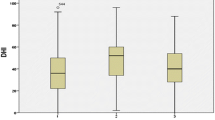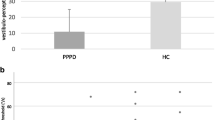Abstract
To assess the possible role of hyperhomocysteinemia (HyHcy) in delaying recovery after acute vestibular neuritis. In our retrospective study, 90 subjects were evaluated within 7 days from the beginning of an acute vertigo. All subjects had high plasma levels of homocysteine (Hcy). 46 patients were treated with homocysteine lowering therapy and betahistine for 1 month, while 44 subjects received only betahistine. Subjective symptoms were evaluated with the Dizziness Handicap Inventory (DHI) questionnaire, administered 7 days after the beginning of vertigo and again after 1 month. Moreover, postural control performed at 1 month’ control was studied with static stabilometry in a subgroup of 21 non-treated and 20 treated patients. DHI total score decreased significantly more in the subgroup of subjects treated with homocysteine lowering therapy. Moreover, posturographic data were significantly increased in non-treated compared with treated subjects. Our data support the possibility of a role of HyHcy in preventing recovery after a recent vestibular neuritis. A microvascular disorder or the neurotoxic effect of HyHcy have been considered as possible causal factors. Although not conclusive, our data are not inconsistent with the hypothesis of a poorer adaptation in patients with untreated HyHcy.
Similar content being viewed by others
References
Maron AB, Loscalzo J (2009) The treatment of hyperhomocysteinemia. Annu Rev Med 60:39–54
Gueant-Rodriguez RM, Gueant JL, Debard R, Thirion S, Hong LX, Bronowicki JP et al (2006) Prevalence of methylenetetrahydrofolate reductase 677T and 1298C alleles and folate status: a comparative study in Mexican, West African, and European populations. Am J Clin Nutr 83:701–707
Rosenberg N, Murata M, Ikeda Y, Opare-Sem O, Zivelin A, Geffen E et al (2002) The frequent 5,10-methylenetetrahydrofolate reductase C677T polymorphism is associated with a common haplotype in whites, Japanese and Africans. Am J Hum Genet 70:758–762
Reynolds E (2006) Vitamin B12, folic acid and the nervous system. Lancet Neurol 5:949–960
Harshman MR, Aldoori W (2008) Vitamin B12 and health. Can Fam Physician 54:536–541
Greene NDE, Stainer P, Copp AJ (2009) Genetics of human neural tube defects. Hum Mol Genet 18:R113–R129
Bostom AG, Silbershatz H, Rosenberg IH, Selhub J, D’Agostino RB, Wolf PA et al (1999) Nonfasting plasma total homocysteine levels and all-cause and cardiovascular disease mortality in elderly Framingham men and women. Arch Intern Med 159:1077–1080
Stubbs PJ, Al-Obaidi MK, Conroy MR, Collinson PO, Graham IM, Noble IM (2000) Effect of plasma homocysteine concentration on early and late events in patients with acute coronary syndrome. Circulation 102:605–610
Abbate R, Sofi F, Brogi D, Marcucci R (2003) Emerging risk factors for ischemic stroke. Neurol Sci 24:S11–S12
Borroni B, Agosti C, Panzali AF, Di Luca M, Padovani A (2002) Homocysteine, vitamin B6 and vascular disease in patients with AD. Neurology 59:1475–1476
Lehmann M, Regland B, Blennow K, Gottfries CG (2003) Vitamin B12–B6-folate treatment improves blood-brain barrier function in patients with hyperhomocysteinemia and mild cognitive impairment. Dement Geriatr Cogn Disord 16:145–150
Lee EJ, Cho YJ, Yoon YJ (2010) Methylenetetrahydrofolate reductase C677T gene mutation as risk factor for sudden sensorineural hearing loss: association with plasma homocysteine, folate and cholesterol concentration. J Laryngol Otol 124:1268–1273
Fusconi M, Chistolini A, de Virgilio A, Greco A, Massaro F, Turchetta R, Benincasa AT, Tombolini M, de Vincentiis M (2012) Sudden sensorineural hearing loss: a vascular cause? Analysis of prothrombotic risk factors in head and neck. Int J Audiol 51:800–805
Fattori B, Nacci A, Ghilardi PL, Bruschini L, Matteucci F, Ursino F (2003) Acute peripheral vertigo: involvement of the hemostatic system. Int Tinnitus J 9:124–129
Scaramella JG (2003) Hyperhomocysteinemia and left internal jugular vein thrombosis with Menière’s symptom complex. Ear Nose Throat J 82:859–860
Herdmann SJ (1998) Role of the vestibular adaptation in vestibular rehabilitation. Otolaryngol Head Neck Surg 119:49–54
Jacobson GP, Newman CW (1990) The development of the Dizziness Handicap Inventory. Arch Otolaryngol Head Neck Surg 116:424–427
Whitney SL, Wrisley DM, Brown KE, Furman JM (2004) Is perception of handicap related to functional performance in persons with vestibular dysfunction? Otol Neurotol 25:139–143
Kao CL, Chen LK, Chern CM, Hsu LC, Chen CC, Hwang SJ (2010) Rehabilitation outcome in home-based versus supervised exercise programs for chronically dizzy patients. Arch Gerontol Geriatr 51:264–267
Beidel DC, Horak FB (2001) Behavior therapy for vestibular rehabilitation. J Anxiety Disord 15:121–130
Dwivedi MK, Tripathi AK, Shukla S, Khan S, Chauhan UK (2011) Homocysteine and cardiovascular disease. Biotechnol Mol Biol Rev 5:101–107
Ho PI, Ortiz D, Rogers E, Shea TB (2002) Multiple aspects of homocysteine neurotoxicity: glutamate excitotoxicity, kinase hyperactivation and DNA damage. J Neurosci Res 70:694–702
Lipton SA, Won-Ki K, Stamler JS (1997) Neurotoxicity associated with dual actions of homocysteine at the N-methyl-d-aspartate receptor. Proc Natl Acad Sci USA 94:5923–5928
Him A, Guneser R, Cengiz N, Ozturk G (2010) Glutamate responsiveness of medial vestibular nucleus neurons in aged rats. Brain Res Bull 81:81–84
Schafer JH, Glass TA, Bolla KI, Mintz M, Jedlicka AE, Schwartz BS (2005) Homocysteine and cognitive function in a population-based study of older adults. J Am Geriatr Soc 53:381–388
Lalonde R, Barraud H, Ravey J, Gueant JL, Bronowicki JP, Strazielle C (2008) Effects of a B-vitamin deficient diet on exploratory activity, motor coordination, and spatial learning in young adult Balb/c mice. Brain Res 1188:122–131
Streck EL, Bavaresco CS, Netto CA, Wyse AT (2004) Chronic hyperhomocysteinemia provokes a memory deficit in rats in the Morris water maze task. Behav Brain Res 153:377–381
Bjelland I, Tell GS, Vollset SE, Refsum H, Ueland PM (2003) Folate, vitamin B12, homocysteine, and the MTHFR 677C-T polymorphism in anxiety and depression. Arch Gen Psychiatry 60:618–626
Levine J, Timinsky I, Vishne T, Dwolatzky T, Roitman S, Kaplan Z et al (2008) Elevated serum homocysteine levels in male patients with PTSD. Depress Anxiety 25:E154–E157
Darlington CL, Smith PF (2000) Molecular mechanisms of recovery from vestibular damage in mammals: recent advances. Prog Neurobiol 62:313–325
Sans N, Sans A, Raymond J (1997) Regulation of NMDA receptor subunit mRNA expression in the guinea pig vestibular nuclei following UVD. Eur J Neurosci 9:2019–2034
Redfern MS, Talkowski ME, Jennings JR, Furman JM (2004) Cognitive influences in postural control of patients with unilateral vestibular loss. Gait Posture 19:105–114
Balaban CD, Jacob RG, Furman JM (2011) Neurologic bases for comorbidity of balance disorders, anxiety disorders and migraine: neurotherapeutic implications. Expert Rev Neurother 11:379–394
Balaban CD, Thayer JF (2001) Neurological bases for balance-anxiety links. J Anxiety Disord 15:53–79
Author information
Authors and Affiliations
Corresponding author
Rights and permissions
About this article
Cite this article
Raponi, G., Teggi, R., Gatti, O. et al. Postural Control in Patients After a Recent Vestibular Neuritis with Hyperhomocysteinemia. Indian J Otolaryngol Head Neck Surg 65, 146–150 (2013). https://doi.org/10.1007/s12070-012-0610-x
Received:
Accepted:
Published:
Issue Date:
DOI: https://doi.org/10.1007/s12070-012-0610-x




